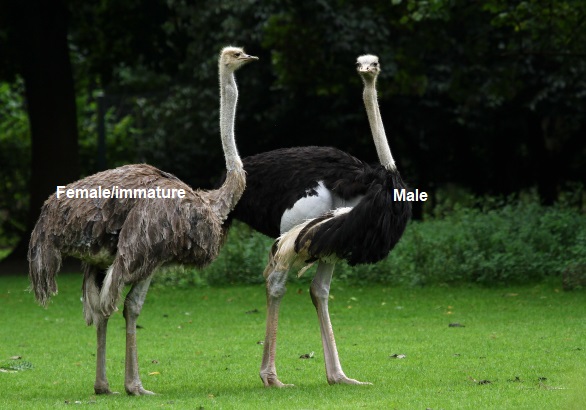
The Common Ostrich(Struthio camelus), also simply known as the Ostrich, is a large flightless bird that is found in Africa. A Common Ostrich can weigh up to 160 kg(352.7 lbs.), this makes it the largest bird on earth. The Common Ostrich is classified in the order Struthioniformes, and the family Struthionidae.
Physical Characteristics
During the breeding season the male Common Ostrich’s body is black; the bare thighs, head, and neck are reddish. There are short stiff brownish feathers encircling the bald crown and extending down the hindneck. the upper mandible is yellowish, and the lower mandible is red. Some of the wing feathers are white.
A Non-breeding male is similar in appearance to a breeding male, but the bare areas of the neck and thighs are pinkish rather than red.
A Female’s body is typically a dull brownish color; a female’s neck and bill become redder during the breeding season.
A juvenile resembles a female.
| Length | 1.7-2.8 m(5’6.9”-9’2.2”) |
| Weight | Weight 60-160 kg(132.3-352.7 lbs.) |
*Subspecies
There are four proposed subspecies of Common Ostrich. Subspecies are populations that show subtle differences from other populations. Subspecies are usually reserved to certain geographic areas.
Range
The Common Ostrich is native to Africa, and can be found in such countries as; Sudan, Eritrea, Uganda, Kenya, Tanzania, Angola, Zimbabwe, Mozambique, and South Africa. This species has also been introduced to Australia.
Habitat
The Common Ostrich inhabits deserts, savannas, and open woodlands.
Breeding
The time of the breeding season varies with region. Mating can occur between just one male and one female, or in groups that consist of one territorial male who mates with one main female called a major hen, and one or several secondary females that are called minor hens. Both sexes are occasionally unfaithful, and may breed with individuals outside their group.
The male builds the nest, which is a shallow scrape in the sand or soil. The amount of eggs laid in a clutch ranges from 2 to 11; the major hen typically lays more eggs per clutch than the minor hens. The major hen and the minor hens lay their eggs in the same nest. The eggs are incubated by both sexes, but of the females typically only the major hen participates in incubating the eggs. The eggs can weigh up to 1.6 kg(3.53 lbs.) The incubation period is 42-46 days. The chicks are covered by light brown down with some black lines and specks..
Diet
The Common Ostrich is Mainly herbivorous It eats grasses, seeds and leaves; it also eats some insects and small vertebrates
Predators
Some of the animals that prey on the Common Ostrich include; big cats, hyenas, canids, and crocodiles. Predators of the nests and young include birds of prey, warthogs, and mongoose.
Conservation Status
The Common Ostrich is listed as least concern.
Fun Facts
- The Common Ostrich can run at speeds up 80km/h(49.71 mph).
- Common Ostriches can survive without drinking water for long stretches of time; they can get the fluid they need from some of the plants they eat.
- The Common Ostrich often defends itself from threats with a powerful kick.
- Contrary to popular belief the Common Ostrich doesn’t bury its head in the sand when it is frightened; However when a Common Ostrich is scared it lies low and presses its whole body to the ground; its head and neck blend in so well with the sandy soil that it looks like its head is buried.
- The Common Ostrich can live for up to 45 years.
